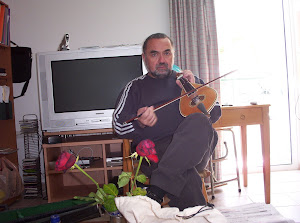Adachi-ga Hara, όλο στο youtube
summary
Priests in search of a night’s lodging stop at the humble hut of a lone woman in the wilds of Adachi.
She finally lets them in and while spinning thread speaks of her wretched solitude. As she leaves to
gather firewood, she tells the priests not to look into her inner room. This arouses the curiosity of a
servant who does look in and finds piled up bones and rotting corpses. The priests realize this must
be the demoness of Adachi, and when they are about to flee, she returns in a rage now in her
demonic form. But finally through Buddhist prayer, the priests are able to quell her anger.
Author: Unknown, although sometimes attributed to Zeami (1363?-1443?).
Scene: Autumn, Adachigahara in Michinoku province, in the present Mihonmatsu city in Fukushima
Prefecture.
Category: Fourth category miscellaneous of fifth category (demon) play, present-time (genzai) noh
in two acts, inori (“prayer”) piece, with taiko stick drum.
Performance practice: performed by all five schools. Adachigahara is the Kanze school name. All
other schools call it Kurozuka (黒塚).
Characters (in order of appearance)
- Waki (secondary actor): Yôkei, a yamabushi mountain priest.
- Wakizure (accompanying waki actors): a companion priest.
- Ai/Ai-kyôgen (interlude actor): a porter-servant for the priests.
- Maejite (first half shite main actor): a village woman. Wears a mature woman (fukai, ômi onna,
or shakumi) mask.
- Nochijite (second half shite): a demoness. Wears a demoness (hannya or shikami) mask.
Synopsis: scene by scene
Stage attendants place a cloth-covered framework hut at center stage.
1. Waki/Wakizure entrance: Two yamabushi priests enter to shidai music and sing of their
dew-drenched sleeves. The main priest introduces himself as Yôkei of the Kumano Nachi
Shrine and together they sing of the austerities of yamabushi and making a pilgrimage
throughout the land as a part of these. They sing a travel song describing their journey from the
Ki peninsula, past the cape of Shiosaki, arriving at the fields of Adachi/ Since there is no village
in sight, they decide to ask for lodgings at a house in the distance.
Stage attendants remove the cloth covering from the framework hut revealing a woman inside.
2. Shite lamentation: The woman sings of the wretched solitude of autumn’s weary world, the cold
winds of down, the emptiness of yesterday, and the uncertainty of life.
3. Waki/Shite exchange: The priest asks for lodging. The woman replies that is is too humble a hut,
but the priests insist there is nowhere else. The woman finally agrees and the chorus describes
how she opens the door for them, the rough reed mat braided with grass upon which they will
sleep, the drew-drenched sleeves of their cloaks, the damp hut, and the misery of a traveler’s
bed.
A stage attendant brings a spinning wheel on stage.
4. Waki/Shite exchange: The priests ask about the spinning wheel. The woman says that poor,
humble women like herself make their living by it. She demonstrates it and refers to the indignity
and bitter toil of the poor. They speak of generosity running deep and the moon shining into the
room. The chorus sings of her spinning the thread, her whishing for the past, and the bitterness
of life’s toils.
5. Shite’s lamentation: The woman in tears speaks of the misery in being born human. The priest
and chorus sing of work itself bringing salvation and if one’s heart is set on the true path, one
cannot fail to attain Buddhahood. The chorus for the woman sings of passing through the karmic
wheel of birth and rebirth, and still holding vain attachments and resentments. Then in an
exchange between the woman and the chorus, there are references to Prince Genji and Lady
Yugao, the Lady’s carriage and the blossoms they viewed, and the drawing out of life’s sorrows
by spinning thread.
6. Shite exit: The woman says she will fetch firewood but as she goes she pointedly tells the
priests not to look in her inner room. The main priest insists he would not think of doing such a
thing.
7. Ai action scene: The servant comments on the woman’s words saying that they should look into
the room. The priest stops him reminding him of their promise. After the priest falls asleep, the
servant peaks in and is shocked to find it full of rotting human bones and corpses. He tells the
priest and then himself runs off in horror.
8. Waki actions scene: The priest too tells of the rotting corpses and foul stench saying this must
the demoness of Kurozuka. The priests sing of being dazed, losing courage, and fleeing.
9. Nochijite entrance: The demoness enters to either the rhythmic hayafue “fast flute” music of the
free rhythmic deha music. She tells the priests to halt telling of her anger at them for looking in
her room. The chorus and the demoness describe the winds, the thunder and lightening, and the
rain, and how a demon once devoured a maiden in one gulp.
10. Shite/waki battle: To inori “prayer” music, the priests vigorously rub their rosaries in order to
defeat the demoness. They pray to the gods in all directions and the chorus sings of Buddha’s
power to punish evil and describes the demoness’ defeat, her agony and shame of her life being
revealed, and her terrible wail as she disappears into the roar of the night storm.(Richard Emmert)
summary
Priests in search of a night’s lodging stop at the humble hut of a lone woman in the wilds of Adachi.
She finally lets them in and while spinning thread speaks of her wretched solitude. As she leaves to
gather firewood, she tells the priests not to look into her inner room. This arouses the curiosity of a
servant who does look in and finds piled up bones and rotting corpses. The priests realize this must
be the demoness of Adachi, and when they are about to flee, she returns in a rage now in her
demonic form. But finally through Buddhist prayer, the priests are able to quell her anger.
Author: Unknown, although sometimes attributed to Zeami (1363?-1443?).
Scene: Autumn, Adachigahara in Michinoku province, in the present Mihonmatsu city in Fukushima
Prefecture.
Category: Fourth category miscellaneous of fifth category (demon) play, present-time (genzai) noh
in two acts, inori (“prayer”) piece, with taiko stick drum.
Performance practice: performed by all five schools. Adachigahara is the Kanze school name. All
other schools call it Kurozuka (黒塚).
Characters (in order of appearance)
- Waki (secondary actor): Yôkei, a yamabushi mountain priest.
- Wakizure (accompanying waki actors): a companion priest.
- Ai/Ai-kyôgen (interlude actor): a porter-servant for the priests.
- Maejite (first half shite main actor): a village woman. Wears a mature woman (fukai, ômi onna,
or shakumi) mask.
- Nochijite (second half shite): a demoness. Wears a demoness (hannya or shikami) mask.
Synopsis: scene by scene
Stage attendants place a cloth-covered framework hut at center stage.
1. Waki/Wakizure entrance: Two yamabushi priests enter to shidai music and sing of their
dew-drenched sleeves. The main priest introduces himself as Yôkei of the Kumano Nachi
Shrine and together they sing of the austerities of yamabushi and making a pilgrimage
throughout the land as a part of these. They sing a travel song describing their journey from the
Ki peninsula, past the cape of Shiosaki, arriving at the fields of Adachi/ Since there is no village
in sight, they decide to ask for lodgings at a house in the distance.
Stage attendants remove the cloth covering from the framework hut revealing a woman inside.
2. Shite lamentation: The woman sings of the wretched solitude of autumn’s weary world, the cold
winds of down, the emptiness of yesterday, and the uncertainty of life.
3. Waki/Shite exchange: The priest asks for lodging. The woman replies that is is too humble a hut,
but the priests insist there is nowhere else. The woman finally agrees and the chorus describes
how she opens the door for them, the rough reed mat braided with grass upon which they will
sleep, the drew-drenched sleeves of their cloaks, the damp hut, and the misery of a traveler’s
bed.
A stage attendant brings a spinning wheel on stage.
4. Waki/Shite exchange: The priests ask about the spinning wheel. The woman says that poor,
humble women like herself make their living by it. She demonstrates it and refers to the indignity
and bitter toil of the poor. They speak of generosity running deep and the moon shining into the
room. The chorus sings of her spinning the thread, her whishing for the past, and the bitterness
of life’s toils.
5. Shite’s lamentation: The woman in tears speaks of the misery in being born human. The priest
and chorus sing of work itself bringing salvation and if one’s heart is set on the true path, one
cannot fail to attain Buddhahood. The chorus for the woman sings of passing through the karmic
wheel of birth and rebirth, and still holding vain attachments and resentments. Then in an
exchange between the woman and the chorus, there are references to Prince Genji and Lady
Yugao, the Lady’s carriage and the blossoms they viewed, and the drawing out of life’s sorrows
by spinning thread.
6. Shite exit: The woman says she will fetch firewood but as she goes she pointedly tells the
priests not to look in her inner room. The main priest insists he would not think of doing such a
thing.
7. Ai action scene: The servant comments on the woman’s words saying that they should look into
the room. The priest stops him reminding him of their promise. After the priest falls asleep, the
servant peaks in and is shocked to find it full of rotting human bones and corpses. He tells the
priest and then himself runs off in horror.
8. Waki actions scene: The priest too tells of the rotting corpses and foul stench saying this must
the demoness of Kurozuka. The priests sing of being dazed, losing courage, and fleeing.
9. Nochijite entrance: The demoness enters to either the rhythmic hayafue “fast flute” music of the
free rhythmic deha music. She tells the priests to halt telling of her anger at them for looking in
her room. The chorus and the demoness describe the winds, the thunder and lightening, and the
rain, and how a demon once devoured a maiden in one gulp.
10. Shite/waki battle: To inori “prayer” music, the priests vigorously rub their rosaries in order to
defeat the demoness. They pray to the gods in all directions and the chorus sings of Buddha’s
power to punish evil and describes the demoness’ defeat, her agony and shame of her life being
revealed, and her terrible wail as she disappears into the roar of the night storm.(Richard Emmert)








No comments:
Post a Comment